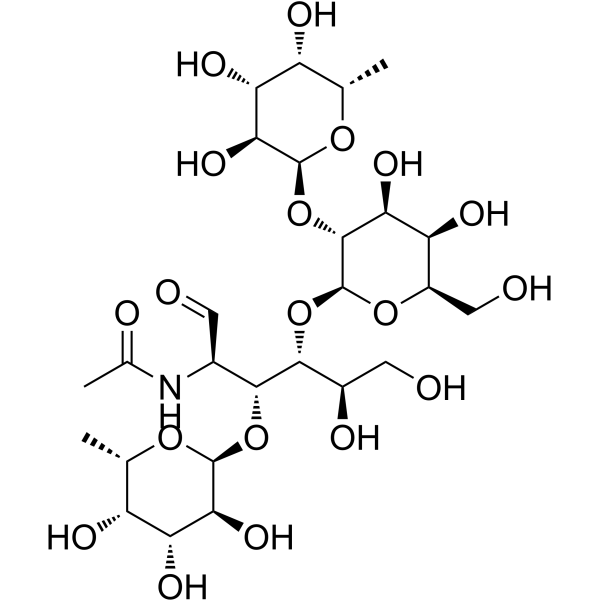Lewis y tetrasaccharide
Modify Date: 2024-01-03 11:52:15

Lewis y tetrasaccharide structure
|
Common Name | Lewis y tetrasaccharide | ||
|---|---|---|---|---|
| CAS Number | 82993-43-9 | Molecular Weight | 675.63100 | |
| Density | N/A | Boiling Point | N/A | |
| Molecular Formula | C26H45NO19 | Melting Point | N/A | |
| MSDS | N/A | Flash Point | N/A | |
Use of Lewis y tetrasaccharideLewis Y tetrasaccharide (Lewis Y, LeY) is a tetrasaccharide derivative form of Lewis X trisaccharide (HY-N10534). Lewis Y tetrasaccharide is an antigen associated with malignant ovarian carcinomas metastasis and poor prognosis[1][2]. |
| Name | LewisYtetrasaccharide |
|---|
| Description | Lewis Y tetrasaccharide (Lewis Y, LeY) is a tetrasaccharide derivative form of Lewis X trisaccharide (HY-N10534). Lewis Y tetrasaccharide is an antigen associated with malignant ovarian carcinomas metastasis and poor prognosis[1][2]. |
|---|---|
| Related Catalog | |
| In Vitro | Lewis Y tetrasaccharide activates FAK signaling pathway and upregulating Bcl-2/Bcl-XL expression to enhance cell adhesion mediated drug resistance (CAM-DR) in ovarian cancer cells[1]. Lewis Y tetrasaccharide results in integrin α5β1 level increase in ovarian carcinoma-derived cells exhibiting enhanced expression of LeY (RMG-1-hFUT)[2]. Lewis Y tetrasaccharide enhances the adhesive and spreading potentials mediated by the integrin-fibronectin interaction of ovarian carcinoma RMG-1 cells[2]. Anti-LeY antibodies (10 μg/mL; 37 ℃; 24 h) significantly inhibits the proliferation and adhesion ability of RMG-1-hFUT cells cultured in vivo[2]. |
| References |
| Molecular Formula | C26H45NO19 |
|---|---|
| Molecular Weight | 675.63100 |
| Exact Mass | 675.25900 |
| PSA | 316.24000 |